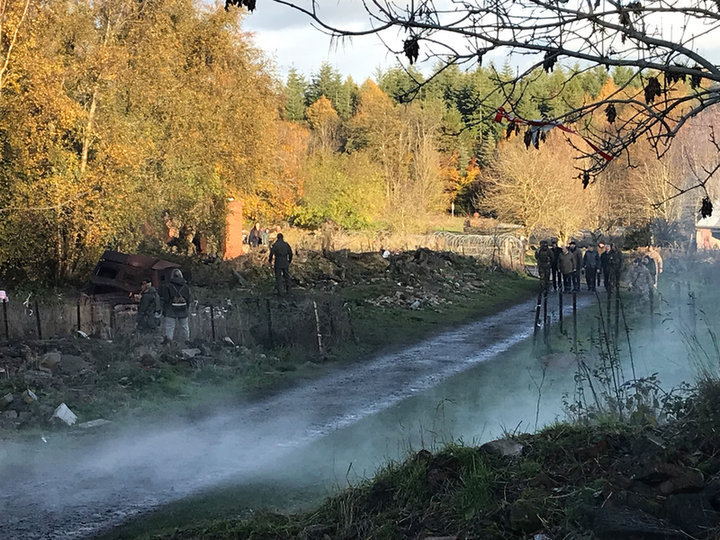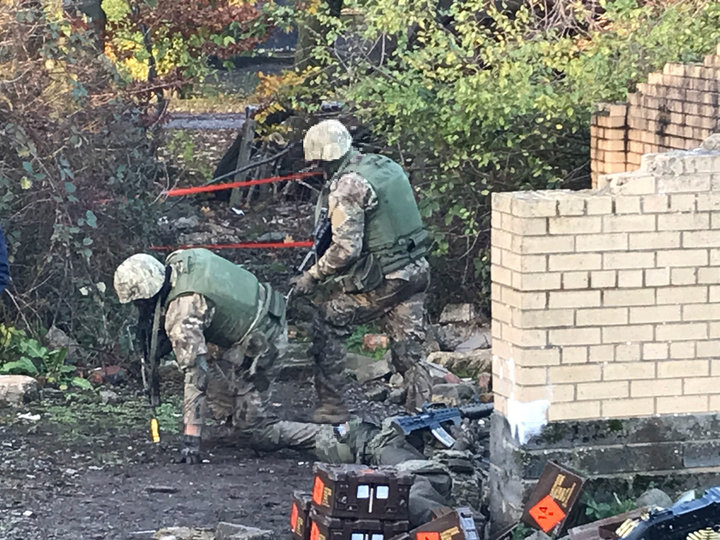UKRAINE WAR
Operation Interflex: Ukrainian recruits prepare for the front line
Thousands of Ukrainian recruits have passed through secretive UK training sites since the summer as part of a concerted effort to deliver effective infantry skills to aid Kyiv’s war effort. Richard Thomas reports.
At a site in the north of England the latest batch of Ukrainian military personnel could be seen embarked on a five-week long course to furnish raw recruits with the basics of infantry soldiering, before the inevitable return to their homeland and the front lines.
The programme, named Operation Interflex, has seen the training of over 7,400 recruits from the Armed Forces of Ukraine (AFU), in addition to another 60 returning soldiers who have completed the British Army’s Section Leader course, enabling them to return as key squad and troop leaders.
During an on-site visit in November, sections of AFU personnel were put through their paces on a simulated urban battlefield, using blank ammunition. The training site includes personnel from members states of the Joint Expeditionary Force (JEF) grouping, comprised of Denmark, Estonia, Finland, Iceland, Latvia, Lithuania, Netherlands, Norway, Sweden, and the UK.
Integrated into the UK’s training site, these overseas personnel are assisting AFU recruits who have little time to get accustomed to their new surroundings, many having never left their country before. More senior AFU personnel are embedded into the training unit’s HQ, with units selected for UK-based training chosen by the government in Kyiv.
The opposing force to the AFU soldiers during the visit is provided by a JEF member state, adding to the immersive environment created in order to “inoculate” what had been Ukrainian civilians to the grim realities of war. The training site includes a reproduction of a Russian trench system as seen on the battlefields in eastern Ukraine.
As AFU soldiers in singles and pairs take turns assaulting the enemy under the guidance of military trainers and translators, blank rounds are fired and returned, as smoke from nearby fires swirl through the air.
An audio recording loudly plays the simulated screams of injured soldiers and cries of civilians, adding another disturbing layer of immersion. The AFU recruits were already midway through their training, in their third week.

// JEF ministers (right) watch on as Ukrainian recruits are put through their latest training evolution, incorporating the recovery of a wounded soldier and assaulting an enemy position: Credit: Richard Thomas
The AFU personnel complete further drills in urban combat, clearing rooms and going house to house in two separate areas. In all three training drills, civilian amputees are hired to provide realistic battlefield casualties, with AFU recruits given first aid skills that could mean the difference between life and death on the front lines.
Following this, individual squads debrief privately in a nearby tent. Out of sight and behind a building near a staging area, AFU troops could be heard shouting slogans.
Brigadier Justin Stenhouse, commanding officer of the British Army’s 11th Security Assistance Brigade, said the recruits were “fighting for their homeland” which lent a different perspective for the trainers under his command.
Stenhouse recounted an anecdote that had filtered back to his unit of a previously trained section of ten AFU soldiers pushing back a Russian force many times their number, testament to the training provided under Operation Interflex.
Crimea and these four provinces are part of Ukraine and they have the right to regain their territorial integrity
- Pål Jonson, Swedish Minister for Defence
In addition, the junior leadership course, which had seen dozens pass through already, took place over a “handful of weeks”, with feedback also provided to AFU leadership as to which basic infantry recruits showed particular aptitude to roles such as section commanders, snipers, and engineers. Around 60 AFU personnel had up to that point undertaken the course.
Lt Colonel Jon Harris of the Light Dragoons said the AFU recruits were fighting against an “existential threat” and were among the “most motivated” he had trained in “20 years of soldiering”.
Asked by Global Defence Technology what UK trainers could in turn learn from Ukraine recruits and those returning for the leadership course, Harris said that the Ukrainians had experience of “fighting a 21st Century adversary on the battlefield”.

// Military trainers working alongside Ukrainian recruits guide them through the course, suggesting courses of action. Translators are on hand to ensure the messages are understood. Credit: Richard Thomas
Currently 1,900 Ukrainian recruits are in the UK taking part in the training programme and will soon return to Ukraine. When they complete the training, they are provided with items including combat clothing, body armour and ear defence, waterproofs and sleeping bags.
Recruits are also issued with a fully stocked individual first aid kit after learning how to use tourniquets, field dressings and chest seals during training. Recruits leaving the UK will now also be provided with extreme cold weather kits, part of a package of 25,000 sets of extreme cold weather clothing, 20,000 sleeping bags and 150 insulated tents, announced by Prime Minister Rishi Sunak on 9 November.
The announcement comes in response to Ukrainian requests for more cold weather equipment, with the winter season dropping the temperature to minus 20°C and below in parts of the country in the coming months.
Heavy duty sleeping bags and roll mats, combined with heated accommodation and personal winter clothing, will help to prevent cold-related injuries and ensure troops can operate effectively and efficiently, a UK Ministry of Defence release stated.

// The training environments that are created as highly realistic in order to prepare recruits for operations on the front line when they return to their country. Credit: Richard Thomas
Russia on the back foot
Considered for so long as having an army on peer with the forces of NATO, Russia’s military machine has struggled in Ukraine. Having opted for a lightning strike to try and decapitate the administration of Volodymyr Zelensky, Moscow’s gains in the early days and weeks following invasion began to turn to stagnation and even retreat.
Ukrainian forces have regained significant portions of territory lost to them at the outset of the invasion, such as around Kharkiv, as well as more recent developments in the south and east with the announcement of a Russian withdrawal from western Kherson to the other side of the Dnipro River.
Senior JEF ministers present at the training site, speaking with gathered media, committed to further aiding the UK-led training missions, as well as providing military equipment.
Kajsa Ollongren, Minister of Defence of the Netherlands, told Global Defence Technology that Dutch troops would undertake two rotations in 2023 in support of Operation Interflex.
Such support has seen Ukraine achieve notable successes on the battlefield, with Kyiv apparently intent on the recovery of all lands occupied by Russia both since the 24 February invasion, but also taken during the 2014 annexation of the Crimean Peninsula.
Pål Jonson, Sweden’s Minister for Defence, said that Crimea “is part of Ukraine” and that Sweden did not recognise the annexation of the peninsula in 2014 or the four provinces occupied in part or whole following the large-scale invasion this year.
“Crimea and these four provinces are part of Ukraine and they have the right to regain their territorial integrity,” Jonson stated.

// A map from 5 December showing the situation on the ground in Ukraine, which has seen Russia lose significant amounts of territory in recent weeks. Credit: UK Defence Intelligence
The UK also took the opportunity to announce its latest package of assistance to Ukraine, committing to the provision of 1,000 surface-to-air missiles with associated launchers to help counter Russian threats to Ukrainian infrastructure, most commonly presented through Iranian-supplied loitering munitions and long-range missile fires. Although the type of missiles was not disclosed, the UK has supplied the Starstreak surface-to-air system to Ukraine.
UK Defence Secretary Ben Wallace said: “This commitment of hundreds more surface to air missiles continues our defensive support for Ukraine against Russian aggression - and will help Ukraine counter the threat from illegal targeting of critical national infrastructure.”
On 10 November, during a JEF meeting in Edinburgh, UK, it was revealed that the Netherlands and Norway would commit further funds to the International Fund for Ukraine (IFU). The fund was initiated by the UK to gather pledges to be used to directly source war materiel for Kyiv. So far, the UK has committed £250m to the IFU, with the fund reaching over £500m.
// Main image: Ukrainian recruits are being given combat training in the UK, aided by military trainers. Images have been altered to protect the identity of Ukrainian personnel and JEF trainers. Credit: Richard Thomas